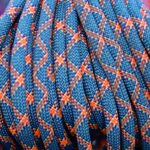Stopper Knots
A stopper knot creates a fixed, thicker point on an otherwise uniform rope preventing the rope from slipping through a narrow hole or retaining device. In climbing a stopper knot helps keep the rope from slipping through the belay device. This protects a climber from potential injury in an extended fall or from potential ground impact.
When belaying, a stopper knot is tied on the belayer’s end of the rope. In this way, the knot can “stop” the climbing rope from slipping all the way through and detaching from the belay device if the climbing and lowering distance is longer than the rope. Various knots can be used as a Stopper Knot. Two of the most common are the Grapevine (or Double Overhand) and the Barrel (or Triple Overhand) knots.

Grapevine (Stopper, Double Overhand)
Also known as the double overhand, it is commonly used as a stopper knot to back up other knots, to secure loose ends of rope or cord, or is placed at the end of the rope to “stop” the rope from passing all the way through a belay device when belaying or rappelling. It is based on the overhand knot with one additional turn around the rope.

Barrel (Triple Overhand)
Also called the triple overhand knot, it is an extension of the overhand knot and the double overhand knot made with a third additional turn around the rope. Like the grapevine or double overhand knot, it can be utilized as a stopper knot in the ends of the rope.
Requiring a stopper knot on all ropes used for top-rope and lead climbing in an indoor climbing facility helps prevent belayers from inadvertently allowing the rope to slip all the way through their hand or belay device while belaying a climber. It avoids a potentially disastrous incident. Experienced climbers know that the belayer’s primary responsibility is to remain in control of the rope and to keep their hold secure at all times while belaying a climber. However, accidents happen for a variety of reasons.
A rope that is too short and without a stopper knot could result in a climber being dropped if the belayer is inattentive or lets go of the rope. Climbing ropes should be the proper length for the climb that is attempted. Indoor climbing facilities maintain lead ropes that are appropriate for the longest potential lead climb in the facility. However, it is possible for lead climbers to pull a top rope and use it for lead climbing the route if appropriate anchors & quickdraws are available. In an indoor climbing facility, a top-rope should only be utilized for the intended climb on which it was set. Guests moving a top-rope to another climb is not allowed because the rope may be too short for another climb. It is also possible to be tempted in some facilities to “link” a shorter climb with another climb and make it longer than the initial, intended route. Requiring a stopper knot in every top-rope and lead climbing rope in the facility provides an extra safeguard against human error.
A stopper knot is a relatively simple solution with few drawbacks that will help prevent situations that could cause injury through inexperience, inattention, or incapacity. Vertical Endeavors requires stopper knots to protect guests and has also made these knots difficult to remove. This helps ensure that they stay in place for every customer. Yes, there is the potential for extra wear on the rope due to the inability to switch the end that the climber ties into and from which the belayer belays. There could be additional stress at places where the rope is in contact with quickdraws and anchors during falls. This stress could happen in the same spots more frequently, causing faster rope wear.
Facility staff continually inspects all ropes for wear and damage. Ropes are replaced whenever there is an indication that it is appropriate to do so, and well before it is necessary. That will continue and likely means that some ropes are likely to be replaced more often. The extra effort and expense to do so is worthwhile if just one incident or injury is prevented.
Climbing is dangerous, it involves inherent and other risks that cannot be completely eliminated. The information presented here does not describe all of the risks associated with climbing and is not intended to replace or supersede expert instruction and training. This article is for informational purposes only and is not a substitute for professional or expert instruction or guidance.
© 2023 Vertical Endeavors, Inc. All rights reserved. The contents of this article, photographs, and graphical representations are protected by U.S. and International copyright laws. Reproduction and distribution, in part or whole, without written permission from Vertical Endeavors are prohibited.

